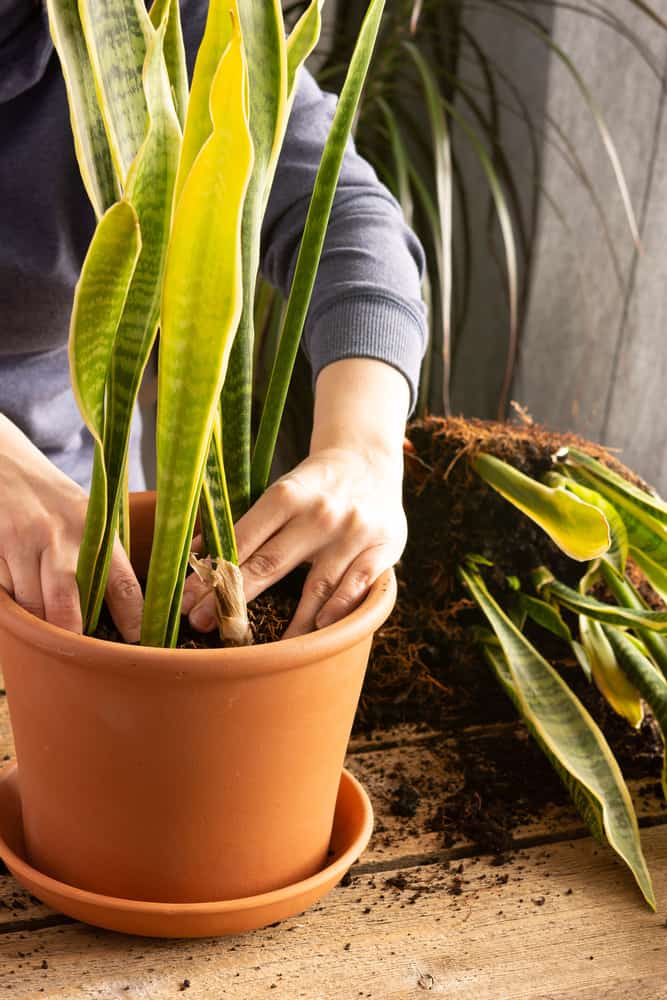The Single Strategy To Use For Snake Plant Leaves Turning Yellow
Wiki Article
Not known Incorrect Statements About Snake Plant Leaves Turning Yellow
Table of ContentsThe Only Guide to Snake Plant Leaves Turning YellowThe Buzz on Snake Plant Leaves Turning YellowThe Ultimate Guide To Snake Plant Leaves Turning YellowA Biased View of Snake Plant Leaves Turning YellowSnake Plant Leaves Turning Yellow Can Be Fun For Everyone
If overwatering in snake plants is not fixed, the yellow patches of your mother-in-law's tongue plant will certainly turn dark brown or black. To dismiss any type of other root causes of serpent plant leaf yellowing, remove the plant from its pot and examine the roots to see if they're soaked and have a nasty scent.
Right here's exactly how to save a serpent plant that's transforming yellow: Stop irrigating your snake plant till the dirt dries up entirely if the yellowing is due to overwatering. Resume watering, but not greater than as soon as weekly. Generally of thumb, avoid watering your serpent plant up until the top 2 inches of the dirt really feel completely dry.
This will certainly aid to enhance water drainage rates, thinking about the high temperature level and sunshine problems throughout the day. Appropriate water drainage requires making use of a fast-draining dirt mix and an expanding pot with drain holes at the base. It is best to make use of a soil mix that contains perlite and crude sand for rapid water drainage.
Snake Plant Leaves Turning Yellow - Questions
There's a positive side as you can grow new plants by propagating minority continuing to be fallen leaves that are still healthy and balanced. Snake Plant Leaves Turning Yellow. ReferralsAdditionally, bugs, disease, overfeeding, lack of some nutrients, or being rootbound are feasible reasons. Let us currently look at each of these reasons. We mean to offer you usual signs connected with each reason and what to do. Water is essential in taking in nutrients necessary for chlorophyll. Absence of water triggers the decay of chlorophyll.

A massive one may cause overwatering, and if it is as well tiny, your plants will dry swiftly. When watering, saturate the soil up until excess water comes from drain openings. Put any water that gathers on the saucer. Finally, never ever adhere to a snake plant sprinkling session. Rather, always feel to make certain the potting mix is completely dry at the very least half-down the pot.
Snake Plant Leaves Turning Yellow for Beginners
If not, provide some leading watering. Lastly, get a harsh price quote on just how often you water your serpent plant and set a pointer to stay clear of overlook. Prior to watering, first, really feel the soil with your finger. Light is essential for the biosynthesis of chlorophyll in all flowering plants. Yet as well a lot will degrade chlorophyll.You can additionally obtain conservatories. In hot summertimes or during warm front, take your plants to cooler locations. Don't place your plants near residence home heating system vents, radiators, fire places, or anything that gives off heat. Finally, prevent temperature abrupt decreases and spikes. They will certainly worry your plant.
An absence will create in-between veins yellowing on young leaves. When it is lacking, plants collect nitrates however fall short to utilize them to make proteins.
Also though snake plants have Homepage a record for being nearly difficult to eliminate, they nonetheless experience a reasonable share of concerns. You are not the only one who has discovered that your snake plant's leaves are transforming yellow. We will certainly analyze the factors serpent plant leaves turn yellow and exactly how to take care of it.
Indicators on Snake Plant Leaves Turning Yellow You Need To Know
Because snake plants are prone to root rot, they will not flourish if sprinkled excessively. This is typically the optimal equilibrium if you let your plant dry however do not let it stay dry. You can water your plant once again as soon as the soil appears dry to the touch.A wet container will certainly consider substantially much heavier than a dry pot, so ultimately, you should certainly have the ability to identify just how completely dry your plant is based upon the mass of its container. Snake plant leaves might become yellow if you allow your plant dry, after that wait up until the soil is entirely dry before rewatering.
You need to consider even more than simply how often you water serpent plants. You also need to consider what strikes the liquid when it is positioned in the pot. After watering your plant, you must not let the origins stick around in water important site for a couple of days because this can create origin rot.
Yellowing fallen leaves can be treated by offering the snake plant the ideal environments and focus. Below are some of the reasons serpent plants turn yellow and soft.
Not known Facts About Snake Plant Leaves Turning Yellow
You just need to use enough supply and make certain right water drainage to allow the added water to drain pipes out. Not way too much neither insufficient; there will be an ideal environment for fungis illnesses if there is any standing water. The snake plants can be sprinkled every 2 to 6 weeks.
After putting them in the morning sun, you will certainly see that serpent plants' growth rate would raise and show up much healthier. Nonetheless, positioning them in the outdoor early morning sunshine will require informative post more water, so once per week is sufficient. Nevertheless, if the location receives excessive sunlight and the surface feels completely dry, you can water them two times weekly.
Report this wiki page